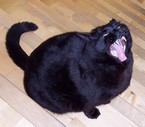Dimitris
Posts: 13282
Joined: 7/31/2005
Status: offline

|
Thanks, there's some really good stuff in these suggestions. I've added them to our internal issue tracker and I want to elaborate on a couple of them.
quote:
agility / turning ability should increase as aircraft lose altitude (more engine power, thicker air so better control surface response)
More specifically, there is an ideal "Q"/Mach number that allows maximum effect of aerodynamic surfaces, correct? The oft-quoted "corner speed" (which we already model) IIRC assumes a low-altitude figure.
quote:
game should handle up/down boresight limits, as well as side/side(if it doesn't already, that is)
I _think_ we do something about this already but we'll check again.
quote:
aircraft should have trouble attacking things above them if they are at a low energy state (to represent nose-above horizon problems at low airspeed)
Tricky :). Have to also allow for the far greater slack allowed by HOB weapons.
quote:
aircraft should run afterburner more in close combat, and climb/dive to maintain energy, rather than chopping to loiter.
We're talking about yo-yo essentially, right?
quote:
some sort of thrust modelling to make sure that some aircraft climb faster than others, a noticeable advantage of some airframes in certain eras.
This is already implemented (and in fact it also varies dynamically with the exact weight, see here: http://www.warfaresims.com/?p=4091) but there was a bug in the code that reduces its effect. The fix should be part of the next release.
quote:
some sort of sustained turn modelling so that some planes will turn noticeably better in close combat. (may already exist?)
Yes, in fact the turn rates are both different per aircraft nominally and also affected by weight (and also aircraft & engine damsge in the future).
quote:
a basic angle limit on mk1 eyeball; many aircraft have extremely limited visibility, especially radar interceptors before 4th gen. in many cases it would be impossible to spot infrared shots from high 6, for instance. in the game i think it's essentially 360 which gives a lot of advantage to certain airframes which should be far more limited in spotting missiles from a defensive posture.
This is in fact something we very much want to do as it ties-in with something else we have in the pipeline (you'll know it when you see it), and since you're interested in this you may be able to help us bring it to life.
We are leaning towards codifying the cockpit-visibility properties of different aircraft in discrete enumerable values. So you would have something like:
#1 - 1960s missile interceptor canopy (F-4, F-104, MiG-21/23/25 etc.) - good front coverage, average side + down coverage, poor rear coverage
#2 - 1970s Teen fighters canopy (F-14/15/16 etc.) - Excellent 360 coverage + strong down-look angle; also applies to Su-27, F-22 etc.
#3 - Typical airliner & derivatives - good frontal coverage, poor side coverage, abysmal down & rear
Having these enumerable values, and applying them to each aircraft individually, would then allow us to define spotting rules for each of them.
Would you be interested in undertaking this? (The data part, that is)
One other thing we want to model is the tendency of pilots to fixate on their primary target during a WVR engagement, leading to "tunnel vision". This would allow modelling both the surprise opportunities endemic in a dogfight ("the one you don't see is the one that kills you") also also magnify the benefit of a two-man crew, since the second pair of eyeballs would be available for scanning around the aircraft while still prosecuting the primary target.
quote:
when aircraft beam or crank, it's often a good idea for them to also lose altitude to "drag" the enemy's missile through the lower atmosphere, and extend both their own airspeed and the range the missile has to travel. this is another avenue where some planes are better than others. they can move through the cycle (burn, climb, shoot, descending crank, turn nose-on, burn, climb, repeat etc) than others due to higher engine power, climbing rate etc.
This makes sense, and we'd gladly implement it if we were able to cross-confirm it as a RL practice. Is there any authoritative source we can consult?
Thanks again.
< Message edited by Sunburn -- 12/24/2016 11:46:27 AM >
_____________________________
|
 Printable Version
Printable Version












 New Messages
New Messages No New Messages
No New Messages Hot Topic w/ New Messages
Hot Topic w/ New Messages Hot Topic w/o New Messages
Hot Topic w/o New Messages Locked w/ New Messages
Locked w/ New Messages Locked w/o New Messages
Locked w/o New Messages Post New Thread
Post New Thread